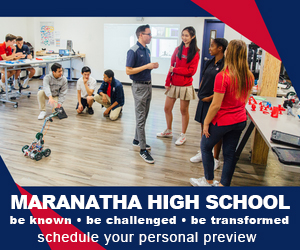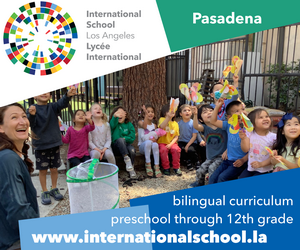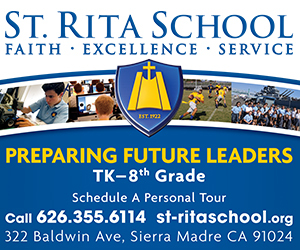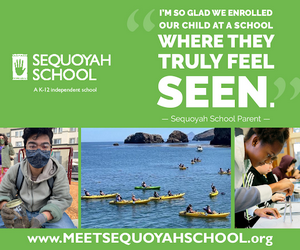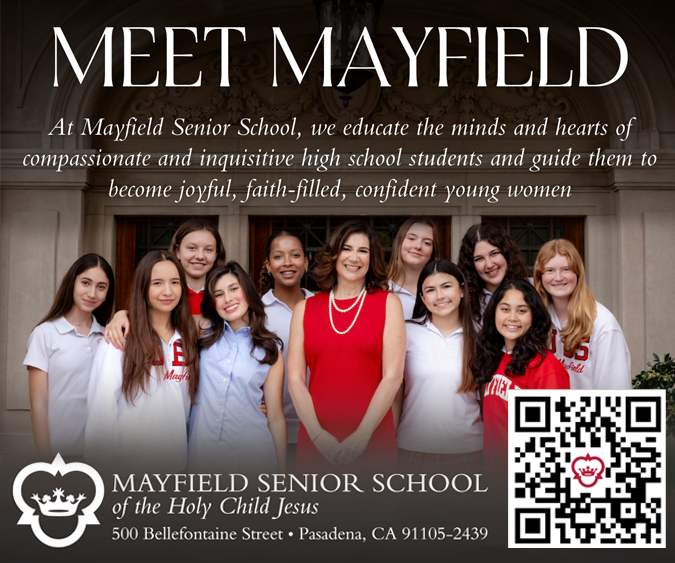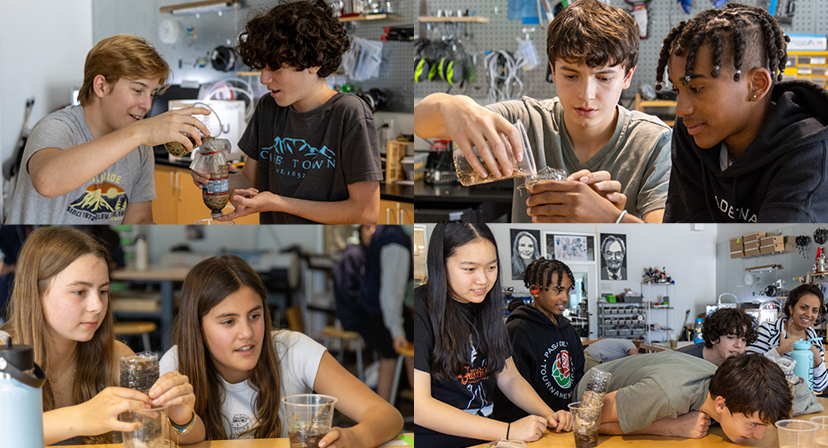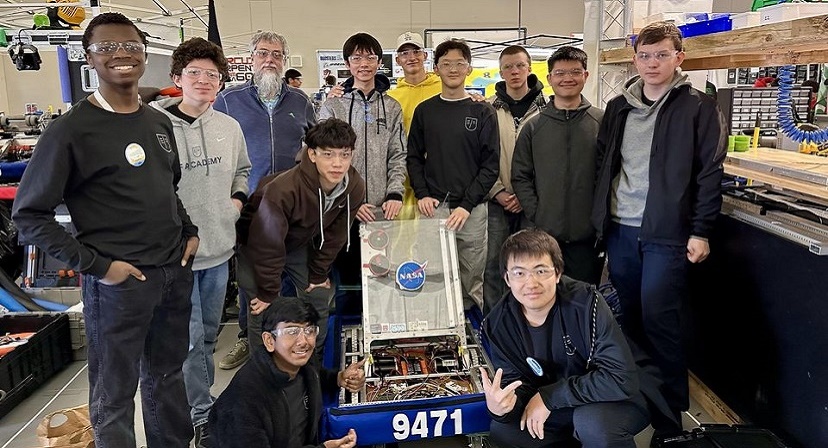Westridge School: Science Labs in Remote Learning: All Grades, Several Approaches, and Working Remarkably Well
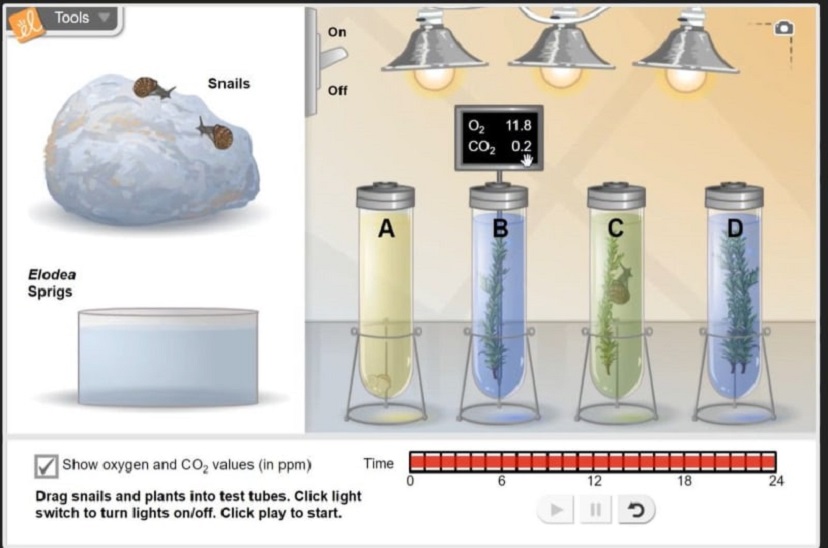
Through a combination of serious supply pickups, materials commonly found at home, and impressive online lab simulations, Westridge teachers are keeping science learning an active endeavor for students this year. All of the teachers we spoke with are pleased with the lab schedule they have been able to keep up (most say they are doing nearly as many labs and all report they are covering the core content and concepts they would in a typical year critical), several mentioned added benefits of lab simulations, and, especially in the upper divisions, faculty emphasized that time devoted to the important skill of data analysis is stronger than ever today.
Read on for some examples of labs from each of the divisions.
Upper School
Dr. Edye Udell, who teaches Honors and AP Chemistry, primarily uses online simulations which she describes as interactive cartoons of what students would traditionally do in the lab (students use their cursor to fill pipettes or put samples in a spectrophotometer, for example). Udell did a great deal of research to find simulations that met her approval but says many “are better than doing the lab in person because kids can repeat the lab five times during class, manipulating different variables each time.” (Note: Lab simulations are available at https://phet.colorado.edu/.) She says that while students are missing out on getting comfortable working with lab equipment and are missing some work in manipulating data, they are learning what is most important and developing their problem-solving skills.
“I am giving the same difficulty and material of tests that I gave last year when we were on campus and they are doing just as well,” said Udell. “I am amazed at the problem-solving abilities of my students and how capable of learning they are in this setting which demands that they be more proactive in figuring out what they need to learn.”
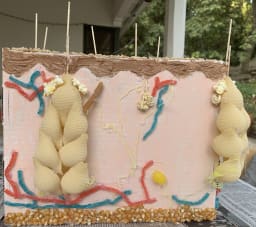 Laura Hatchman reports that the number of labs in her classes has not decreased and that many of the labs in her 9th grade biology and anatomy classes were activity based (as opposed to the “wet labs” of chemistry) and translated well to remote learning. For instance, students created skin models, and also built DNA models with materials found at home, rather than from a template in class, which students really enjoyed.
Laura Hatchman reports that the number of labs in her classes has not decreased and that many of the labs in her 9th grade biology and anatomy classes were activity based (as opposed to the “wet labs” of chemistry) and translated well to remote learning. For instance, students created skin models, and also built DNA models with materials found at home, rather than from a template in class, which students really enjoyed.
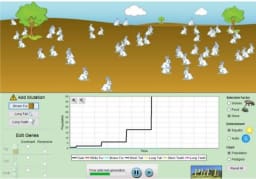 For some labs, including one on natural selection and frog dissection, she turned to Phet simulations (see above and note that dissection simulations were always offered as an alternative to the traditional approach). Hatchman also finds that simulations provide several benefits over in-class labs. “They are really well done and offer a lot of versatility to run a lot of simulations in a short amount of time. They serve the same purpose as the process we do in class, but allow us to spend more time on analysis, which is often cut short due to the time it takes to execute hands-on projects.” Hatchman also noted that field journals were added to the Ecology class curriculum, because students were able to go outside for observations consistently over six weeks.
For some labs, including one on natural selection and frog dissection, she turned to Phet simulations (see above and note that dissection simulations were always offered as an alternative to the traditional approach). Hatchman also finds that simulations provide several benefits over in-class labs. “They are really well done and offer a lot of versatility to run a lot of simulations in a short amount of time. They serve the same purpose as the process we do in class, but allow us to spend more time on analysis, which is often cut short due to the time it takes to execute hands-on projects.” Hatchman also noted that field journals were added to the Ecology class curriculum, because students were able to go outside for observations consistently over six weeks.
Middle School
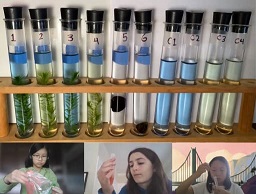 Barbra Chabot says she has kept to her regular schedule of labs by combining three approaches: hands-on labs with materials provided by the school, hands-on labs using items typically found at home or easy to procure (e.g., an egg, corn syrup, and vinegar), and online simulations. Among other things, her 7th grade students have grown and measured seedlings, cultured bacteria in Petri dishes, extracted DNA from a strawberry, used an egg to model osmosis, and found evidence of photosynthesis and respiration in aquatic plants and snails. “Most of the hands-on labs we do together online. I will demonstrate the experiment live on the screen while they are doing their own work at home,” says Chabot.
Barbra Chabot says she has kept to her regular schedule of labs by combining three approaches: hands-on labs with materials provided by the school, hands-on labs using items typically found at home or easy to procure (e.g., an egg, corn syrup, and vinegar), and online simulations. Among other things, her 7th grade students have grown and measured seedlings, cultured bacteria in Petri dishes, extracted DNA from a strawberry, used an egg to model osmosis, and found evidence of photosynthesis and respiration in aquatic plants and snails. “Most of the hands-on labs we do together online. I will demonstrate the experiment live on the screen while they are doing their own work at home,” says Chabot.
The big loss to the 7th grade curriculum in remote is working with microscopes, which Chabot tries to bridge through a combination of online simulations where the students manipulate virtual scopes, and by hooking up a digital microscope to her computer so students can “look” through the lens along with her. “The students have gotten quite a bit of hands-on work, but they are missing out on the energy of being in the lab together,” said Chabot. “But as a department we have been talking about how the most important skill we teach is analysis of data – scientific thinking, looking at what evidence indicates, asking what is happening and why, and they are learning that.”
Lower School
 In the Lower School, where the tactile skills of hands-on experimentation are still being developed, teachers sent home a full semester of supplies for lab activities. Among many other labs, 6th graders created air trolleys that sailed across fishing line in their engineering unit and built solar ovens (and cooked smores) when studying heat transfer. Fifth graders grew wheat seeds to learn about photosynthesis (those grown in black bags were yellow.) Oreo cookies turned out to be the perfect materials for modeling the phases of the moon (split in half and sculpt the cream and perhaps snack unused “classroom supplies”).
In the Lower School, where the tactile skills of hands-on experimentation are still being developed, teachers sent home a full semester of supplies for lab activities. Among many other labs, 6th graders created air trolleys that sailed across fishing line in their engineering unit and built solar ovens (and cooked smores) when studying heat transfer. Fifth graders grew wheat seeds to learn about photosynthesis (those grown in black bags were yellow.) Oreo cookies turned out to be the perfect materials for modeling the phases of the moon (split in half and sculpt the cream and perhaps snack unused “classroom supplies”).
“Our program is inquiry-based. We emphasize process and skills, not just content, so it was important to continue our lab program,” said Liz Kim, who teaches 5th and 6th grade science. According to Kim, her classes are doing fewer labs than in a regular year due to the extra time required for labs remote, but are covering most of what would be covered, and she is thrilled by the engagement and creativity of the students. “I am not able to watch and guide their scientific skills as I would in person, but students are exercising the same skills – just practicing in different ways.”
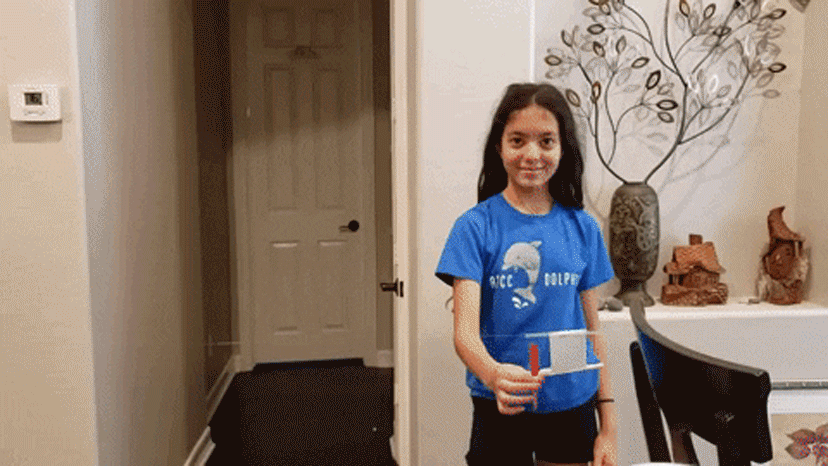
Click here to see more photos from this semester’s at-home science labs!
Westridge School, 324 Madeline Drive, Pasadena, (626) 799-1053 ext. 200 or visit www.westridge.org.





